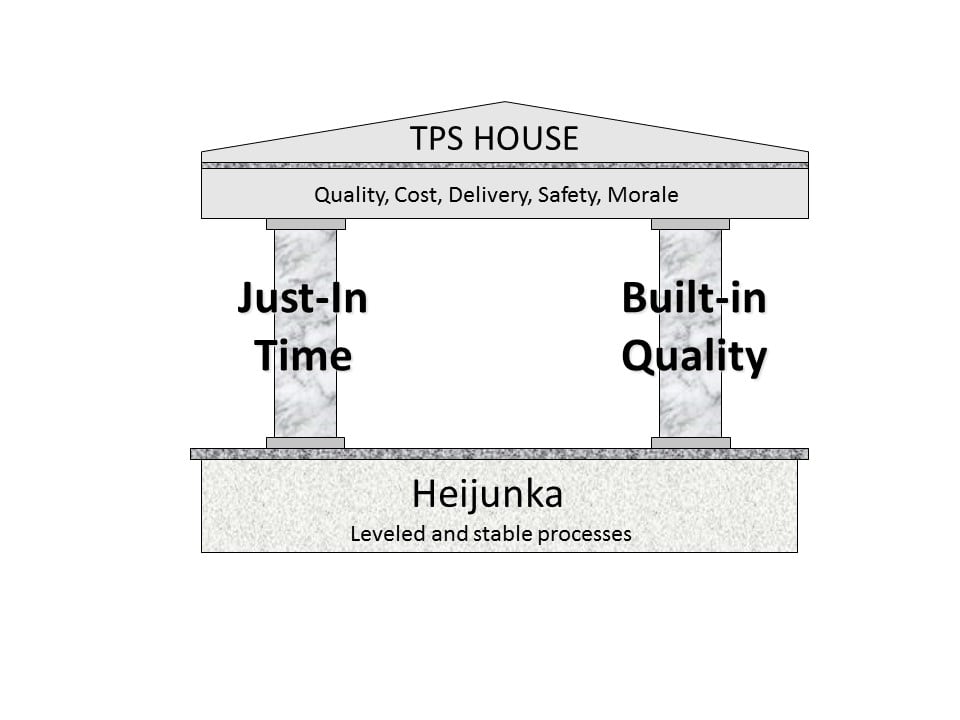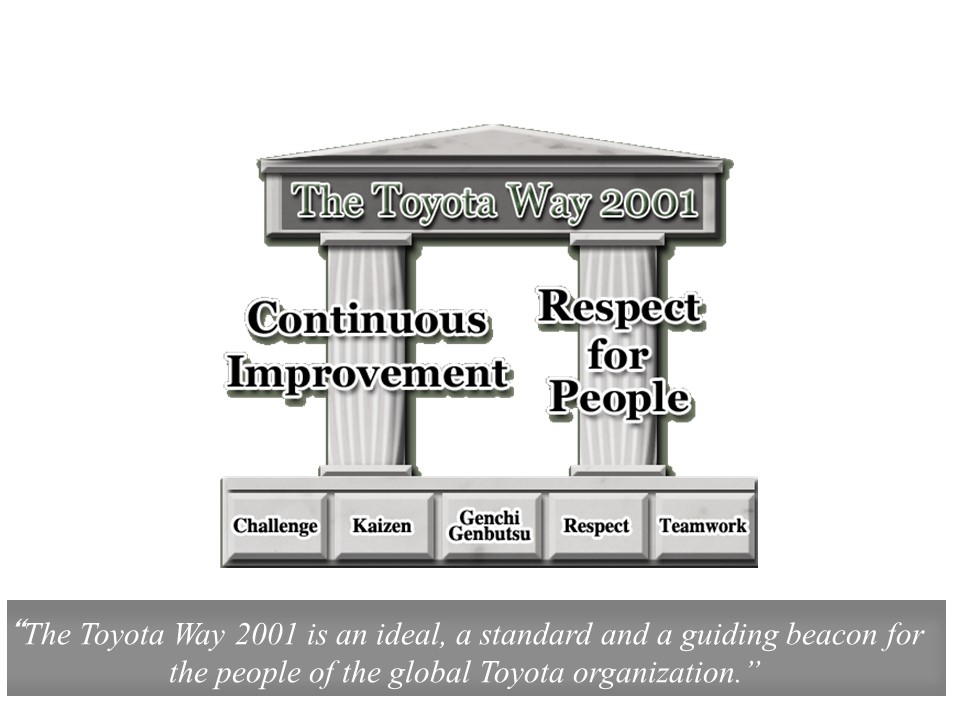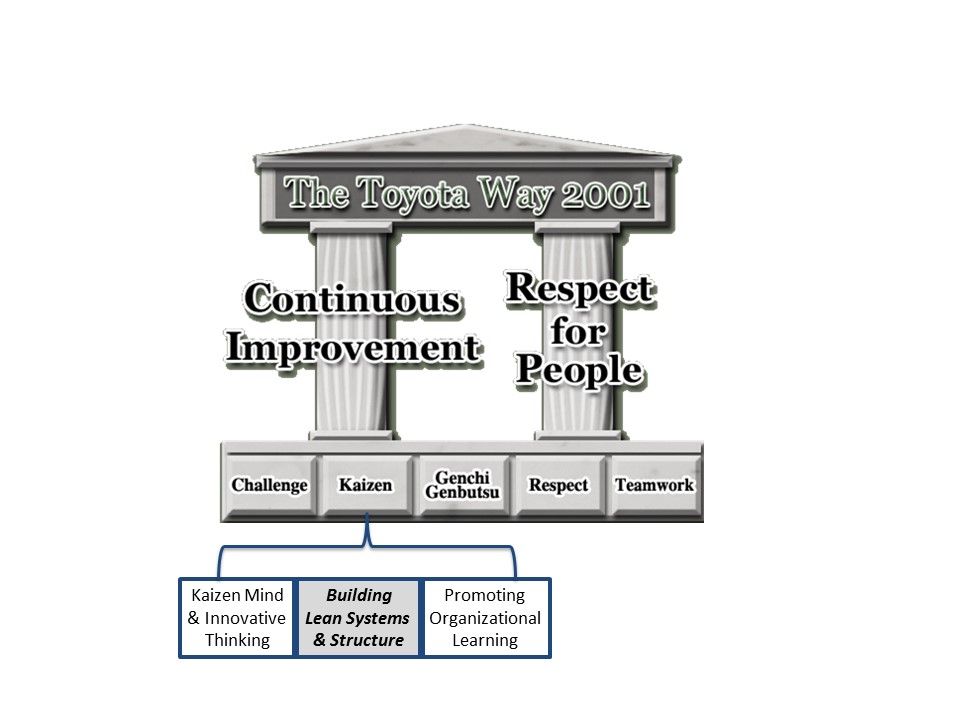The Toyota Way 2001 House: Lean for the 21st Century
For decades, the Toyota Production System (TPS) house has symbolized lean. Many companies have crafted their own version of the TPS modeled after this house. Yet, Toyota created the Toyota Way 2001 house as a more general image of the core of its company’s culture.

The TPS in its simplest form is a powerful image.
The Just-in-Time concept provides a vision of flowing value directly to the customer without interruption. Increasingly, customers want customized products and services on demand. Built-in Quality follows the principle of doing it right the first time to avoid downstream rework. The foundation of the house suggests it is not possible to flow value smoothly and perform each step correctly, when there is chaos and instability. So, we need to level the flow of work to make it steady and consistent. Many manufacturing and service organizations that have followed these principles have had dramatic success in eliminating waste, streamlining processes, saving money and better serving customers. As seen in the figure above, the goal in the roof of the house suggests that doing these things will improve quality, cost, delivery, safety and morale. It is shown as a system in which all the parts are interconnected, as in a structure—like a house.

However, what is missing from this image is the people who are building and rebuilding the house to adapt to a dynamic environment. It is a static image. Often, people continuously improving are put in the center of the house, but when implementing the TPS, many organizations focus mainly on the tools of Just-in-Time and Built-in Quality.
The Toyota Way 2001 was introduced to provide a more holistic, human-centered image for the people of Toyota.

In this image, respect for people and continuous improvement are front and center. These apply to any organization of people trying to continually get better in a changing environment. It is a dynamic image of people coming together to strive for excellence. The foundational values are:
- Challenge: Stretch and develop us to creatively reach the goal
- Kaizen: Systematic problem solving that never ends
- Genchi Genbutsu: Observe to understand the actual situation
- Teamwork: Highly developed individuals working toward a goal
- Respect: People are our only appreciating asset
The lean concepts reflected in the TPS are a part of kaizen, as seen below.

Notice that one of the three elements of kaizen is “building lean systems and structure.” That includes what we think of as the TPS, such as Just-in-Time, Built-in Quality, and eliminating waste, unevenness and overburden.
Why would Toyota bury the essence of lean so deep within the house, essentially as a footing of the foundation? The reason is that the lean systems are powerful, yet limited. The essence of the Toyota Way is people creatively working to achieve the challenges necessary to survive in a volatile and often hostile world. Toyota is always thinking of the future, and how to use the creativity of all of its people to stay competitive and financially strong, while providing a good quality of life for its people. Eliminating waste alone through lean systems will never lead to the innovation necessary to stay competitive and healthy.
For example, Toyota has made huge leaps ahead in its product and processes. One example is innovation in the automobile assembly line. In the past, car bodies were flown around the factory hung on large and expensive conveyors, and then brought to the ground for assembly on conveyors deeply rooted into the concrete of the floor. These were inflexible. When vehicles were remodeled, or when jobs were consolidated through improvements, it was very expensive to change these conveyors.
Over the last decade, Toyota began experimenting with alternatives to the conveyor line. They made changes in their Motomachi plant where they make many vehicles on the same line. Car doors were brought on inexpensive carts by automated guided vehicles to a holding area, where they were then brought one-by-one to an assembly line. The carts on wheels linked together and became the assembly line. Small motors pushed them along. This was then extended to the main assembly line where inexpensive motors pushed the car along.
Now, about ten years later it was announced that Toyota has a new flexible assembly line. This and other production innovations will allow Toyota to change the production lines over to produce a new product at half the cost, and the assembly line can be reconfigured over a weekend instead of a month. This will allow Toyota to be profitable at a broad range of volumes, instead of depending on full capacity to make money. Flexibility to adapt to the environment has been a major focus for Toyota, particularly since the Great Recession when like other companies, Toyota lost money.
We can see the principles of the TPS in these innovations, but what drives them is people creatively meeting a challenge. Respect for people and continuous improvement are what drive Toyota forward.
Dr. Jeffrey Liker is professor of industrial and operations engineering at the University of Michigan and author of The Toyota Way. He leads Liker Lean Advisors, LLC and his latest book (with Gary Convis) is The Toyota Way to Lean Leadership.
Some opinions expressed in this article may be those of a contributing author and not necessarily Gray.
Related News & Insights
Manufacturing
Applying the Toyota Production System (TPS) to Automated Manufacturing Processes: Honsha Example
Industry
July 26, 2013Manufacturing
How Akio Toyoda Is Living Up to the True Toyota Way
Industry
October 09, 2014Manufacturing
Why Toyota is Lean...and You're Not
Opinion
July 16, 2012